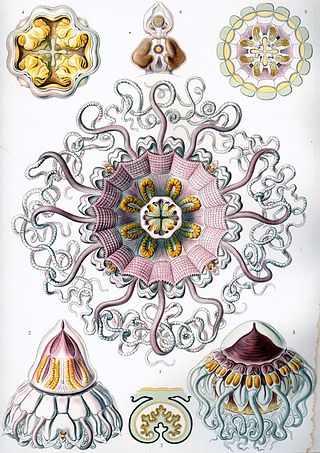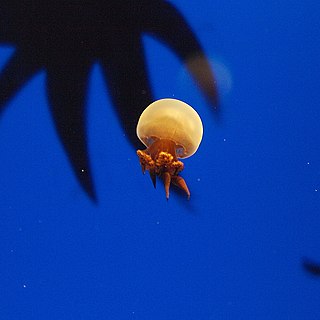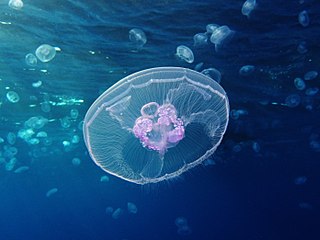
Semaeostomeae is an order of large jellyfish characterized by four long, frilly oral arms flanking their quadrate mouths. The umbrella is domed with scalloped margins, and the gastrovascular system consists of four unbranched pouches radiating outwards from the central stomach; no ring canal is present. They usually possess eight tentacles; four are per-radical and four are inter-radical.

Crown jellyfishes are the six families of true jellyfish that belong to the order Coronatae. They are distinguished from other jellyfish by the presence of a deep groove running around the umbrella, giving them the crown shape from which they take their name. Many of the species in the order inhabit deep sea environments.

Periphyllidae is a family of jellyfish containing four genera and six species. The most well-known member of the family, Periphylla periphylla, is usually considered a deep-sea species, but it forms large blooms in surface waters of Norwegian fjords.

Nausithoidae is a family of jellyfish.

Rhopilema is a genus of jellyfish.

Chrysaora is a genus of jellyfish, commonly called the sea nettles, in the family Pelagiidae. The origin of the genus name Chrysaora lies in Greek mythology with Chrysaor, brother of Pegasus and son of Poseidon and Medusa. Translated, Chrysaor means "he who has a golden armament."

Franz Josef Maria Werner was an Austrian zoologist and explorer. Specializing as a herpetologist and entomologist, Werner described numerous species and other taxa of frogs, snakes, insects, and other organisms.

Atolla is a genus of crown jellyfish in the order Coronatae. The genus Atolla was originally proposed by Haeckel in 1880 and elevated to the monotypic family level, as Atollidae by Henry Bigelow in 1913. The six known species inhabit the mesopelagic zone. The medusae possess multiple lobes called lappets at the bell margin. Medusae also have eight tentacles, alternating with eight rhopalia, and twice as many lappets occur as tentacles.

Aurelia is a genus of scyphozoan jellyfish, commonly called moon jellies. There are currently 25 accepted species and many that are still not formally described.

Nausithoe aurea, also known as the Nausithoe maculata, is a species of crown jellyfish found off the southeastern coast of Brazil. The central disc has been measured to be 10.5 mm. N. aurea is transparent with yellow and brown spots located around the gonads. N. aurea can reproduce either asexually by strobilation or sexually. Either ephyrae or planuloids may be produced by strobilation; only ephyrae can produce the medusal form. Strobilation can be induced to occur when food is abundant. In polyps, a large availability of food leads to strobilation if it is not regulated. N. aurea species usually take more than 20 weeks to begin the differentiation and development of reproductive organs.

Lucernariidae is a family of stalked jellyfish containing two genera.

Prayidae is a family of marine invertebrates in the order Siphonophorae. They are colonial, and the colonies can superficially resemble jellyfish; although they appear to be a single organism, each specimen is actually a colony of Siphonophora.

Forskalia is a genus of siphonophores. It is the only genus in the monotypic family Forskaliidae.

Alatina is a genus of box jellyfish within class Cubozoa. It is the largest of the three known genera in the family Alatinidae, and the only one which is not monotypic. It contains the following ten species:

Chrysaora chinensis, or the Indonesian sea nettle, is a species of jellyfish in the family Pelagiidae. It is native to the central Indo-Pacific region and its sting is considered dangerous.
Chrysaora africana, the purple compass jelly, is a species of jellyfish from the family Pelagiidae. Found in the southeastern Atlantic Ocean from Gabon to the western coast of South Africa, its taxonomy has historically caused considerable confusion. Like other sea nettles, its sting is painful, but not generally dangerous unless there is an allergic reaction to the venom.
Atolla vanhoeffeni is a species of true jellyfish in the family Atollidae.
Stephanoscyphistoma is a genus of crown jellyfish. Its taxonomic placement has been disputed, having been placed in Hydrozoa and Scyphozoa, and additionally having contained former members that were discovered to produce medusae belonging to the genera Atorella and Nausithoe.
Nausithoe picta is a species of crown jellyfish in the family Nausithoidae. It is found in the south Pacific Ocean.













